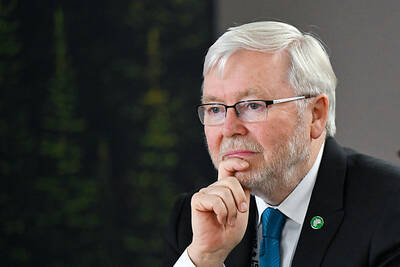Five glaring errors were discovered in one paragraph of the world’s most authoritative report on global warming, forcing the Nobel Prize-winning panel of climate scientists who wrote it to apologize and promise to be more careful.
The errors are in a 2007 report by the Intergovernmental Panel on Climate Change (IPCC), which is affiliated with the UN. All the mistakes appear in a subsection that suggests glaciers in the Himalayas could melt away by 2035 — hundreds of years earlier than the data actually indicates. The year 2350 apparently was transposed as 2035.
The climate panel and even the scientist who publicized the errors said they are not significant in comparison to the entire report, nor were they intentional. And they do not negate the fact that worldwide, glaciers are melting faster than ever. But the mistakes open the door for more attacks from climate change skeptics.
“The credibility of the IPCC depends on the thoroughness with which its procedures are adhered to,” Yvo de Boer, head of the UN Framework Convention on Climate Change, said in an e-mail. “The procedures have been violated in this case. That must not be allowed to happen again because the credibility of climate change policy can only be based on credible science.”
The incident follows a furor late last year over the release of stolen e-mails in which scientists talked about suppressing data and freezing out skeptics of global warming.
In a statement, the climate change panel expressed regret over what it called “poorly substantiated estimates” about the Himalayan glaciers.
“The IPCC has established a reputation as a real gold standard in assessment; this is an unfortunate black mark,” said Chris Field, a Stanford University professor who in 2008 took over as head of this part of the IPCC research. “None of the experts picked up on the fact that these were poorly substantiated numbers. From my perspective, that’s an area where we have an opportunity to do much better.”
Patrick Michaels, a global warming skeptic and scholar at the libertarian Cato Institute, called on the head of the IPCC, Rajendra Pachauri, to resign, adding: “I’d like to know how such an absurd statement made it through the review process. It is obviously wrong.”
The report in question is the second of four issued by the IPCC in 2007 on global warming. This 838-page document had chapters on each continent. The errors were in a half-page section of the Asia chapter. The section got it wrong as to how fast the thousands of glaciers in the Himalayas are melting, scientists said.
“It is a very shoddily written section,” said Graham Cogley, a professor of geography at Trent University in Canada, who brought the error to everyone’s attention. It wasn’t copy-edited properly.”
Cogley wrote a letter about the problems to Science magazine that was published online on Wednesday. He said he remains convinced that the great bulk of the work in the IPCC volumes was trustworthy.

NEXT GENERATION: The four plants in the Central Taiwan Science Park, designated Fab 25, would consist of four 1.4-nanometer wafer manufacturing plants, TSMC said Taiwan Semiconductor Manufacturing Co (TSMC, 台積電) plans to begin construction of four new plants later this year, with the aim to officially launch production of 2-nanometer semiconductor wafers by late 2028, Central Taiwan Science Park Bureau director-general Hsu Maw-shin (許茂新) said. Hsu made the announcement at an event on Friday evening celebrating the Central Taiwan Science Park’s 22nd anniversary. The second phase of the park’s expansion would commence with the initial construction of water detention ponds and other structures aimed at soil and water conservation, Hsu said. TSMC has officially leased the land, with the Central Taiwan Science Park having handed over the

AUKUS: The Australian Ambassador to the US said his country is working with the Pentagon and he is confident that submarine issues will be resolved Australian Ambassador to the US Kevin Rudd on Friday said that if Taiwan were to fall to China’s occupation, it would unleash China’s military capacities and capabilities more broadly. He also said his country is working with the Pentagon on the US Department of Defense’s review of the AUKUS submarine project and is confident that all issues raised will be resolved. Rudd, who served as Australian prime minister from 2007 to 2010 and for three months in 2013, made the remarks at the Aspen Security Forum in Colorado and stressed the longstanding US-Australia alliance and his close relationship with the US Undersecretary

‘WORLD WAR III’: Republican Representative Marjorie Taylor Greene said the aid would inflame tensions, but her amendment was rejected 421 votes against six The US House of Representatives on Friday passed the Department of Defense Appropriations Act for fiscal 2026, which includes US$500 million for Taiwan. The bill, which totals US$831.5 billion in discretionary spending, passed in a 221-209 vote. According to the bill, the funds for Taiwan would be administered by the US Defense Security Cooperation Agency and would remain available through Sept. 30, 2027, for the Taiwan Security Cooperation Initiative. The legislation authorizes the US Secretary of Defense, with the agreement of the US Secretary of State, to use the funds to assist Taiwan in procuring defense articles and services, and military training. Republican Representative

TAIWAN IS TAIWAN: US Representative Tom Tiffany said the amendment was not controversial, as ‘Taiwan is not — nor has it ever been — part of Communist China’ The US House of Representatives on Friday passed an amendment banning the US Department of Defense from creating, buying or displaying any map that shows Taiwan as part of the People’s Republic of China (PRC). The “Honest Maps” amendment was approved in a voice vote on Friday as part of the Department of Defense Appropriations Act for the 2026 fiscal year. The amendment prohibits using any funds from the act to create, buy or display maps that show Taiwan, Kinmen, Matsu, Penghu, Wuciou (烏坵), Green Island (綠島) or Orchid Island (Lanyu, 蘭嶼) as part of the PRC. The act includes US$831.5 billion in